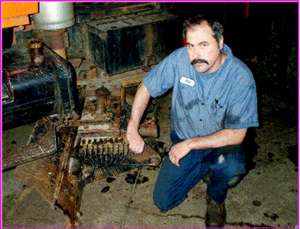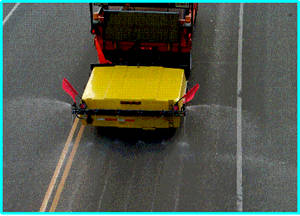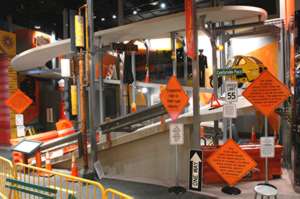 |
 |
|
 |
Slayton’s Craig Gertsema changes roles during response to Lake Wilson blast |
 |
 |
 |
Maintenance workers from the Marshall Region clear debris following
a powerful explosion in the city of Lake Wilson. Photo by Craig Gertsema
|
Craig Gertsema, an emergency medical technician, was among the first to arrive
in Lake Wilson shortly after 11 p.m. on Jan. 13 after a powerful explosion destroyed
the city’s fire station and caused extensive damage to nearby homes and businesses.
Gertsema, a senior transportation generalist at Willmar/District 8’s Slayton
Truck Station, also serves as an EMT with the Murray County ambulance service.
After a house-to-house search determined there were no injuries, Gertsema went
back to the fire station, called his supervisor, George Bowman, and then returned
to Lake Wilson with Bowman to help law enforcement agencies set up traffic barricades
along Hwy 91.
The next morning, Gertsema traveled once again to Lake Wilson to work with
other Marshall Region employees and Murray County maintenance crews to clear
debris blown onto the highway by the blast.
Lake Wilson is located at the intersection of Hwy 91 and Hwy 30 in Murray County,
about 35 miles southwest of Marshall.
Mn/DOT maintenance crews from the region’s Marshall, Ivanhoe, Lake Benton,
Pipestone, Slayton and Tracy truck stations helped clear debris and reopen the
highway and city streets to traffic. The Mankato District also supported the
recovery effort by loaning a self-propelled broom to District 8 crews.
Observers said impact from the blast was felt as far as 25 miles away. Gov.
Tim Pawlenty visited the site on Jan. 14 to demonstrate support for the community
of about 300 people.
Gertsema said the devastation was the worst he has seen in his nearly seven
years as an EMT.
Responding to emergencies is commonplace for district maintenance forces, including
District 8. The district has supported several recovery operations following
floods, tornadoes and major snowstorms that have struck the region in recent
years, said Sandy East, district public affairs coordinator.
By Craig Wilkins
|
back

|
 |
State Employee Appreciation Week: A Message from Lt. Gov. Carol Molnau |
 |
 |
Gov. Tim Pawlenty has proclaimed Jan. 26-30 "State Employee Appreciation
Week." In recognition of the week I would love to be able to speak with
each of you, but it would just be logistically impossible. I do not, however,
want to miss the opportunity to express my appreciation.
While it may be difficult to demonstrate to each one of you how much I appreciate
what you do for Mn/DOT and the state, let me give it a try.
I appreciate it when:
- You get up in the middle of the night to face the cold and plow our roads
- You design a road improvement to make travel safer
- You help protect Minnesota’s natural resources
- You talk with concerned citizens
- You complete payroll transactions
- You write a news release to help educate Minnesotans about transportation
- You work with our partners and stakeholders
- You greet the visitors at the front desk with a smile
- You try new ideas like design-build
- You incorporate all modes of transportation into the discussion
- You look for internal savings and efficiencies
- You testify before a legislative committee
- You handle schedules and correspondence
- You keep our information technology on the cutting edge
- You help us comply with contracting laws
- You interview with a news reporter
- You review plans to make sure they are correct
- You involve the public in our decision-making processes
- You work with counties and cities
- You help us plan for the long term
- You develop methods to make the roads safer
- You train your fellow employees in new techniques
- You use your engineering expertise to keep Mn/DOT a transportation leader
- You work compassionately with citizens when acquiring their land
- You compile facts, numbers and reports
This list would need to be much longer for me to express my appreciation to
each of you—your contributions to this state are endless.
This past year was an historic year of activity, performance and accomplishment
for Mn/DOT and I want to emphasize to all 5,000 of you that you have delivered
exceptional service and value to Minnesota taxpayers. For that I thank you.
Next week there will be a variety of activities in the various offices and
districts to show appreciation; I hope you will be able to participate. Even
though the week has been designated appreciation week, that doesn’t mean we
shouldn’t appreciate each other throughout the year. Take the time to say thank
you whenever you can—it’s easy and reaps many rewards.
|
back

|
 |
Governor proposes $85.5 million transportation bonding bill |
 |
 |
Funding for the Northstar corridor commuter rail line is one of the top items
on Gov. Tim Pawlenty’s $85.5 million wish list for transportation, according
to the capital bonding proposal he announced Jan. 13.
In addition to $37.5 million for the Northstar commuter rail, the governor's
proposal includes $38 million for local roads and bridges as well as $10 million
for the Cedar Avenue busway.
Adopted in even-numbered years, capital budgets fund projects that include
the acquisition of land and the construction and repair of state agency buildings,
facilities, parks and trails. Capital budgets also cover grants to local governments
for repair and construction of schools, parks and bridges.
Under the governor’s proposal, the Northstar commuter rail line would connect
downtown Minneapolis to communities along a 40-mile stretch to Big Lake, using
existing rail lines for the most part.
"The fast-growing corridor between Minneapolis and St. Cloud needs congestion
relief and more commuter options," Pawlenty said. "This project will help."
The governor's plan includes an initial $37.5 million state investment for
the Northstar Commuter Rail to be matched by $37.5 million in local funding.
The total cost of the project is estimated to be at least $265 million, of which
the federal government will pay half.
In July 2003, Pawlenty asked the Federal Transit Authority to conduct an independent
analysis of the Northstar Commuter Rail to determine the plan's cost effectiveness.
Since then, the corridor has undergone substantial changes in order to meet
FTA requirements.
Also included in the governor’s transportation bonding proposal is $10 million
for the Cedar Avenue busway, which will go from the Mall of America in Bloomington
to Lakeville in the southern Twin Cities metropolitan area. The money will pay
for preliminary engineering and environmental assessments, short-term improvements
on Cedar Avenue and construction of a park-and-ride on Cedar Avenue and Hwy
13.
In addition, Pawlenty is recommending $28 million be used for bridge replacements
in Greater Minnesota. The money would leverage $40 million in federal and local
funds to replace approximately 170 deficient bridges throughout the state. The
proposal also includes $10 million for road improvement projects of state and
regional significance.
For more information, see:
|
back

|
 |
Newsletter editor, FHWA laud Mn/DOT’s work zone safety program |
 |
 |
Mn/DOT’s efforts to improve work zone safety efforts drew praise from Bernie
Wagenblast, editor of the online "Transportation Communications Newsletter,"
and from the Federal Highway Administration.
The FHWA’s recognition was printed in its December 2003 issue of its online
newsletter.
The newsletter cited Mn/DOT’s study to find safer, more effective ways for
traffic to merge before entering work zones and its work zone safety recognition
program.
The offices of Construction and Traffic, Security and Operations conduct the
recognition program to encourage innovation in work zone safety in order to
better protect highway workers and the traveling public.
The program honors resident and project engineers, inspectors, safety coordinators
and contractors for their work to improve safety in work zones.
In recent years, awards have been presented that recognize effective communication
among Mn/DOT, contractor and community members, innovative use of technology
and timing of projects to minimize conflict with highway travel.
Mn/DOT started its statewide recognition program in 1989.
The FHWA’s current newsletter honors the state of Oregon for its work zone
safety program. The newsletter can be accessed at http://www.ops.fhwa.dot.gov/wz/index.asp.
By Craig Wilkins
|
back

|
 |
Mankato’s inventiveness chips away at improving winter maintenance work |
 |
 |
 |
Bill Finnegan, heavy equipment mechanic, displays the grease bank he
developed to make lubricating snowplows easier and faster. Photo
Kelvin Smith
|
Winter can chill just about anything, but not the determination of Mankato
Maintenance Area employees to improve snowplowing operations.
For example, using the innovative "grease bank" enables mechanics
and plow drivers to lubricate hard-to-reach fittings on snowplows more easily
and more quickly than usual.
The device, fabricated by Bill Finnegan, a heavy equipment mechanic at Mankato,
makes it easy to apply lubricants to dozens of hard-to-reach grease fittings
on snowplows.
The grease banks use hoses to pump lubricants to 75 or more fittings on each
snowplow.
The grease banks allow operators to reach all of the fittings without having
to crawl under the truck with a grease gun. They speed the process and help
ensure that some fittings aren’t overlooked in order to save time during a snowstorm.
Finnegan said using the banks cuts the service time needed from about 45 minutes
to less than 10.
Ensuring that proper lubrication is done also extends the service life of the
equipment, particularly the underbody plows that bear stress from the truck’s
weight and movement as they scrape ice and snow from the road surface.
The grease bank stems from an idea proposed by Finnegan and funded by the Maintenance
Operations Research Unit. Finnegan, who grew up on a farm near Austin, adapted
the idea from devices used for farm machinery.
 |
|
A Mankato crew uses a trailer equipped with a crash
cushion and an anti-icing spray bar to prevent ice build-up on a district
highway.
|
First tried two years ago, the grease bank is now installed on all of the maintenance
area’s snowplows. John Tarnowski, maintenance research project manager, said
the device’s success led to its specification for new snowplows.
Out on the road, Mankato maintenance crews are testing a new anti-icing chemical
to determine its effectiveness.
Crews are using an anti-icing product that mixes calcium chloride, brine and
Anderson’s Additive, an anti-corrosive chemical. It will be monitored to determine
how it performs under a variety of weather and road conditions, said Gary Martinson,
Mankato area maintenance superintendent.
To improve safety when crews apply liquid anti-icing chemicals, Mankato staff
also installed a tank and spray bar on a unit with a truck-mounted crash attenuator.
The attenuator provides a greater margin of safety for motorists and operators
in the event of a crash by absorbing the impact’s force. The truck also carries
an arrow and message boards to alert drivers about the anti-icing operation.
Randy Glaser, a transportation generalist at Mankato, initiated using the attenuator.
Glaser also leads converting a 6,000-gallon semi-trailer water tanker for high-speed
anti-icing use.
When the tanker gets a new diesel-powered pump and other modifications, it
will support anti-icing efforts on high-traffic routes such as Hwy 169 and Hwy
14 in the Mankato area.
Glaser, a 17-year employee, said the cooperative spirit at the Mankato shop
encourages him and others to find new ways to do things.
"When we have fewer people," he said, "we have to keep working
better and working smarter."
Martinson said other innovations, including an automated cone setter, are in
various stages of development.
"There’s some amazing technology in use out there," he said. "Working
with MORE has really paid off for us."
By Craig Wilkins
|
back

|
 |
New operator, funding bring improvements to Albert Lea’s transit service |
 |
 |
Expanded transit service in the city of Albert Lea started in July with the
selection of a new service provider and the addition of two new buses.
Cedar Valley Services, which also provides transit services for the elderly
and people with disabilities in the city, operates the newly designated Albert
Lea Transit system, said Jean Meyer, transit planner with Rochester/District
6.
The system will provide both regular route and dial-a-ride service Monday through
Fridays with three wheelchair-lift equipped buses.
Funding for the services will come from fares, a 20 percent match from local
governments and a $162,000 grant from the Federal Transit Administration. Meyer
said additional funds come from donations and subscriptions from employers to
ensure bus service includes their locations.
Meyer said the new service will help meet growing transit needs in the city
of 18,000 in southern Minnesota’s Freeborn County.
By Craig Wilkins
|
back

|
 |
Highway research facility supports students’ study of solar system |
 |
 |
The focus at the Mn/ROAD facility on I-94 shifted from the roadway to the heavens
the evening of Jan. 8 when students from the St. Michael-Albertville Middle
School displayed science projects along the perimeter of the low-volume test
track loop.
Testing was halted to allow students to set up their displays about the earth,
its moon, the sun and other bodies in the solar system. Students used the building
at Mn/ROAD to show their work as well.
The displays were arrayed along the 1.1-mile test track in distances relative
to their positions with each other in space.
Teachers, parents and about 150 students strolled between the stations during
the event known as the "Solar System Walk."
The test site’s distance from the core of the Twin Cities metro area also helped
students view the stars and planets after dark. Students whose work focused
on Saturn could look up and see the planet that night as they discussed their
project with visitors, said Paul Keranen, research operations engineer, Office
of Materials.
"The kids had a great time and also learned a lot," wrote science
teacher Ann-Marie Foucalt to Ben Worel, Mn/ROAD operations engineer. "We
are fortunate to have great people like all of you who are willing to go out
of their way to help young people."
Keranen said the event provided a convenient setting to display students’ work
and an opportunity for the staff at Mn/ROAD to interact with area community
members.
Mn/ROAD, more formally known as the Minnesota Road Research Program, uses the
low-volume track and a 3.5-mile section of westbound I-94 near St. Michael to
test several highway pavement designs under actual traffic and weather conditions.
The facility opened in 1994.
By Craig Wilkins
|
back

|
 |
History Center’s transportation exhibit now open |
 |
 |
 |
The Minnesota History Center’s new exhibit, "Going Places: The Mystique
of Mobility," opened Jan. 17. Staff from Mn/DOT and other transportation-related
organizations contributed to the exhibit. Photo by Dave Gonzalez
|
Looking for a stroll through Minnesota’s transportation history? Then the Minnesota
History Center’s new exhibit, "Going Places: The Mystique of Mobility," might
be right for you.
The exhibit, which opened Jan. 17, runs through 2009. It uses photos, videos,
maps and postcards to trace how American passion for mobility has shaped Minnesota.
Representatives from Mn/DOT and other transportation-related organizations worked
with the history center staff to develop the exhibit.
Hours of the exhibit are 10 a.m. to 8 p.m. Tuesday; 10 a.m. to 3 p.m. Wednesday
through Friday; 10 a.m. to 5 p.m. Saturday; noon to 5 p.m. Sunday. Visitors
can view the exhibit free of charge. The History Center is located at 345 Kellogg
Blvd., about four blocks south of the state Capitol.
For more information, see the Jan.
7, 2004 Mn/DOT Newsline or the History
Center Web site.
|
back

|
 |
|
 |



